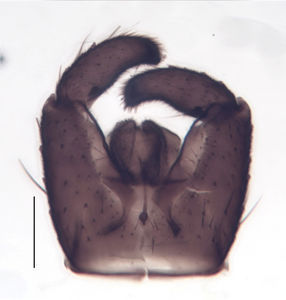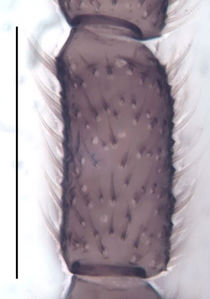Trichosiopsis melanopilosa
Ordo: Diptera
Familia: Sciaridae
Genus: Trichosiopsis
Name
Trichosiopsis melanopilosa unpublished
Type material
Holotype: ♂, 30.06.2012, leg. Haseke, ZFMK-TIS-2567048 in ZFMK
Type locality
Germany, Bavaria, Nationalpark Berchtesgadener Land, Königstal-Alm
Barcoded material studied
| Stadium | Country | Province | Locality | Habitat | Method | Date | Collector | Collection Number | Collection | Latitude | Longitude | Elevation (m) |
|---|---|---|---|---|---|---|---|---|---|---|---|---|
| 1 ♂ (holotype) | Germany | Bavaria | Nationalpark Berchtesgadener Land, Königstal-Alm, Quelle 2 SE Holzstube | Sweep Netting | 30.06.2012 | Harald Haseke | ZFMK-TIS-2567048 | ZFMK | 47.5667 | 13.0153 | 1200 | |
| 1 ♂ (paratype) | Germany | Bavaria | Nationalpark Berchtesgadener Land, Königstal-Alm, Quelle 2 SE Holzstube | Sweep Netting | 30.06.2012 | Harald Haseke | ZFMK-TIS-2567049 | ZFMK | 47.5667 | 13.0153 | 1200 | |
| 1 ♂ (paratype) | Austria | Lower Austria | Rothwald, Dürrenstein, Obere Quelle Rothausbach | Sweep Netting | 29.07.2014 | Harald Haseke & Christina Remschak | ZFMK-TIS-2547945 | ZFMK | 47.783 | 15.083 | 1152 |
Description (male)
Head. Eye bridge 4–5 rows of facets. Antenna unicolour. LW-index of 4th flagellomere 1.8–2.2; neck 0.27–0.38 × segment width; transition of basal part to neck pronounced. Colour of neck unicolour. Antennal setae shorter than segment width; of normal strength; sparse; salient. Palpus darkened; of normal length; palpomeres 3. First palpomere of normal shape; with 2–4 setae; with only sparse sensilla. Second palpomere short and oval. Third palpomere as long as first. Thorax. Colour brown. Notum unicolour. Thoracic setae normal; black. Posterior pronotum setose. Postpronotal setae 3–5; fine. Mesothoracic sclerites bare. Legs. Colour yellow-brown. Hind coxa darkened. Setae on front coxa darkened. Front tibial organ as patch of setae; front tibial organ not bordered. Tibial setae on hind legs normal, shorter than tibial width. Tibial spurs of equal length. Claws untoothed. Wing. Wing slightly darkened; of normal shape. Wing membrane without macrotrichia. Wing venation weak, with faint stM. M-fork of normal shape. R1 ending at or slightly before base of m-fork; posterior veins with macrotrichia; stM with a few macrotrichia; CuA1 and CuA2 mostly with macrotrichia; bM bare; r-m with few setae; bM:r-M 0.7–0.9; st-Cu:bM 0.4–0.55; R1:R 1.3–1.6; c:w 0.75–0.83. Halter darkened; of normal length. Abdomen. Abdominal setae dense; on tergites black; on sternites black. Hypopygium concolour with abdomen; LW-index 0.75–0.9. Base of gonocoxites with weak setae; gonocoxites broadly separated; inner margin of gonocoxites typically U-shaped; inner membrane of hypopygium scarcely setose; ventral margin of gonocoxite with short setae. Gonostylus elongate; LW-index 2.55–2.75; Inner margin concave; apex tapered, or equally rounded. Apical tooth present; without internal structure; of medium strength; LW-Index 1.2–2. Awl-like setae normal; present beneath apical tooth. Megasetae absent. Whiplash-hair absent. Tegmen 0.55–0.7 × longer than broad; rectangular with rounded edges; without special features; central process absent. Length of ejaculatory apodeme/hypopygium 26–37 %; base of ejaculatory apodeme present. Field with aedeagal teeth inconspicuous. Measurements. Body size 2.8–3.5 mm. Hind tibia 1.3–1.5 mm. Wing length 3–3.4 mm.
Diagnosis
Trichosiopsis melanopilosa is placed in the Trichosiopsis pilosa group by the presence of short setae at the base of the gonocoxites and a not very strong apical tooth, which is partially covered by a dorsal bulge. The dense arrangement of awl-like setae around the apical tooth is similar to Trichosiopsis melanoma, but the gonostylus is longer, more tapered and apically more rounded.
DNA Barcoding
The COI sequence is assigned to BIN BOLD:ACU5129 (average distance 0,1%, n=3, K2P: 7.22%)
Discussion
Trichosiopsis melanopilosa is intermediate between Trichosiopsis melanoma and Trichosiopsis pilosa based on morphology and also on genetic similarity. The presence of this and other species in this complex indicates, that it constitutes a natural phylogenetic unit, which would have not become clear, knowing only the two previously described species.
Etymology
The name was combined as mixture between melanoma and pilosa because of the intermediate position between these both species.
Ecology
Tr. melanopilosa appears to be an alpine species, as all known records are from altitudes of more than 1,000 m.
Distribution
Austria, Germany
Images
|




